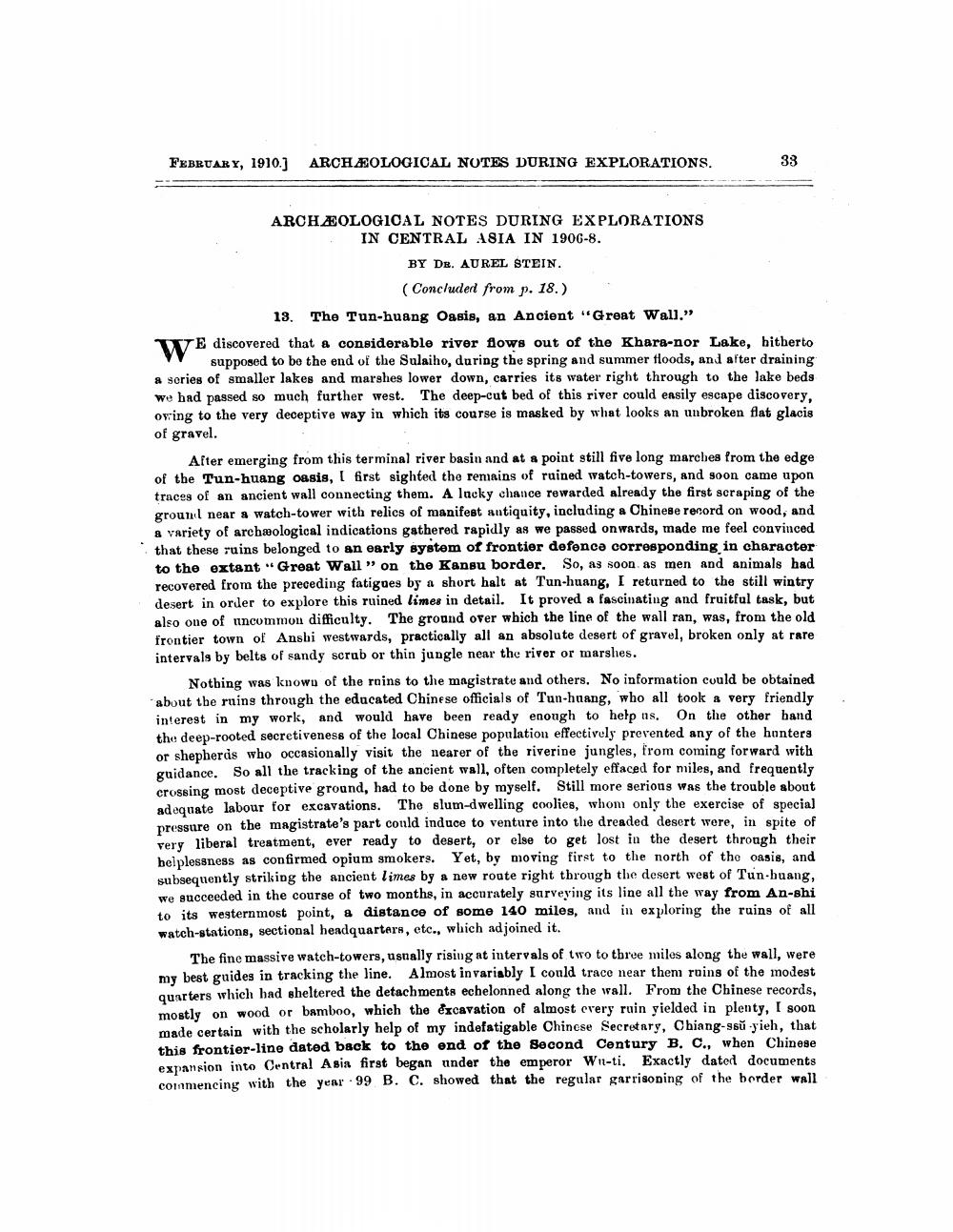________________
FEBRUARY, 1910.) AROH ROLOGICAL NOTES DURING EXPLORATIONS.
33
ARCHÆOLOGICAL NOTES DURING EXPLORATIONS
IN CENTRAL ASIA IN 1906-8.
BY DR. AUREL STEIN.
(Concluded from p. 18.) 13. The Tun-huang Oasis, an Ancient "Great Wall." W E discovered that a considerable river flows out of the Khara-nor Lake, hitherto
supposed to be the end of the Sulaiho, during the spring and summer floods, and after draining a series of smaller lakes and marshes lower down, carries its water right through to the lake beds we had passed so much further west. The deep-cut bed of this river could easily escape discovery, oving to the very deceptive way in which its course is masked by what looks an unbroken flat glacis of gravel.
After emerging from this terminal river basin and at a point still five long marebes from the edge of the Tun-huang oasis, I first sighted the remains of ruined watch-towers, and soon came upon traces of an ancient wall connecting them. A lacky chance rewarded already the first scraping of the ground near a watch-tower with relics of manifest antiquity, including a Chinese record on wood, and & variety of archæological indications gathered rapidly as we passed onwards, made me feel convinced that these ruins belonged to an early system of frontier defence corresponding in character to the extant "Great Wall” on the Kansu border. So, as soon as men and animals had recovered from the preceding fatigues by a short halt at Tun-huang, I returned to the still wintry desert in order to explore this ruined limes in detail. It proved a fascinating and fruitful task, but also one of uncommon difficulty. The ground over which the line of the wall ran, was, from the old frontier town of Ansbi westwards, practically all an absolute desert of gravel, broken only at rare intervals by belts of sandy scrub or thin jungle near the river or marshes.
Nothing was knowo of the rains to the magistrate and others. No information could be obtained about the ruins through the educated Chinese officials of Tun-huang, who all took a very friendly interest in my work, and would have been ready enough to help us. On the other hand the deep-rooted secretiveness of the local Chinese population effectively prevented any of the hunters or shepherds who occasionally visit the nearer of the riverine jungles, from coming forward with guidance. So all the tracking of the ancient wall, often completely effaced for miles, and frequently crossing most deceptive ground, had to be done by myself. Still more serious was the trouble about adequate labour for excavations. The slum-dwelling coolies, whom only the exercise of specia) pressure on the magistrate's part could induce to venture into the dreaded desert were, in spite of very liberal treatment, ever ready to desert, or else to get lost in the desert through their helplessness as confirmed opium smokers. Yet, by moving first to the north of the oasis, and subsequently striking the ancient limes by a new route right through the desert west of Tun-buang, we succeeded in the course of two months, in accurately surveying its line all the way from An-shi to its westernmost point, & distance of some 140 miles, and in exploring the ruins of all watch-stations, sectional headquarters, etc., which adjoined it.
The fine massive watch-towers, usually rising at intervals of two to three miles along the wall, were my best guides in tracking the line. Almost invariably I could trace near them ruins of the modest quarters which had sheltered the detachments echelonned along the wall. From the Chinese records, mostly on wood or bamboo, which the excavation of almost every ruin yielded in plenty, I soon made certain with the scholarly help of my indefatigable Chinese Secretary, Chiang-ssū yieh, that this frontier-line datod back to the end of the Second Century B, C., when Chinese expansion into Central Asia first began under the emperor Wi-ti. Exactly dated documents commencing with the year - 99 B. C. showed that the regular garrisoning of the border wall




